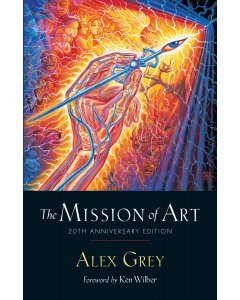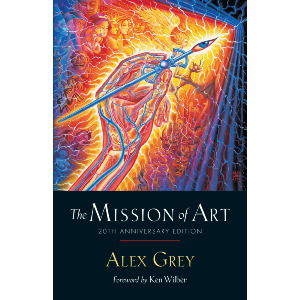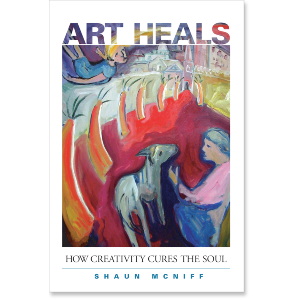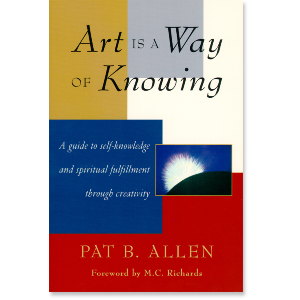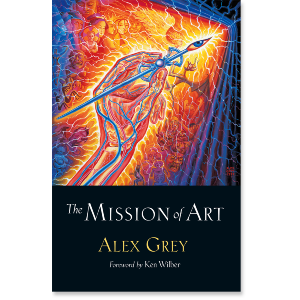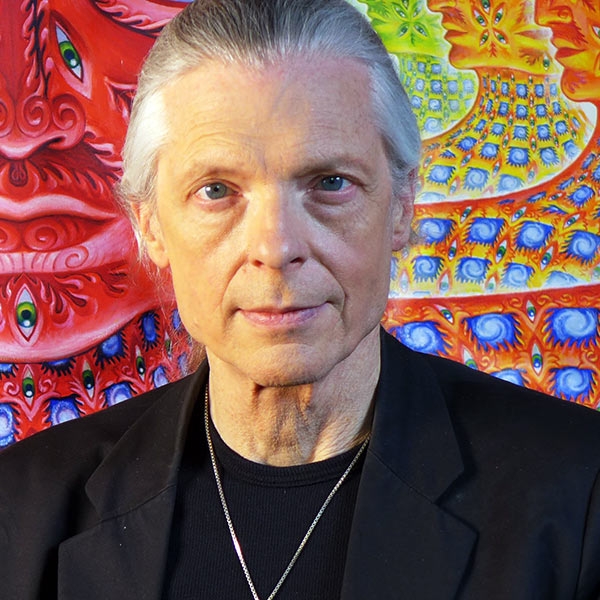

Alex Grey
Alex Grey is best known for his depictions of the human body that “x-ray” the multiple layers of reality and reveal the interplay of anatomical and spiritual forces. His paintings have been featured in venues as diverse as the album art of the Beastie Boys, Newsweek magazine, the Discovery Channel, rave flyers, and sheets of blotter acid. Grey’s artworks have been exhibited and performed throughout the world and are chronicled in the book Sacred Mirrors: The Visionary Art of Alex Grey. He lives in New York City.
Alex Grey
GUIDES
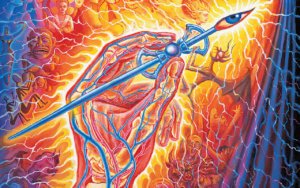
The Mystic Eye | An Excerpt from The Mission of Art
When I was nineteen years old I had a dream in which I opened the lid of a trash can and saw myself with one side of my head shaved bald. The other side had long hair. This strange vision haunted me. Looking in the mirror I would imagine half of my hair missing. I did not understand this dream, but felt that it was important. At first I thought that I could paint the image to exorcise it. Employed as a billboard artist at the time, I was able to paint a large self-portrait and find a ‘‘dead board’’ on which to mount the image. The obsession was still not subdued, so I shaved my hair the way it had appeared in my dream. Even then the experience was not complete for me. I did a series of public performances displaying my split persona. I maintained this haircut for half a year, during which time I wrote and gave a great deal of thought to what the image and my actions might mean.
I came across Robert Ornstein’s research into the hemispheres of the brain in which he distinguishes between the largely rational functions of the left hemisphere and the intuitive functions of the right. I was allowing for the unrestricted growth of the intuitive (the hairy side) and eliminating or reducing the ‘‘tentacles of reason’’ from the rational (the daily shaved side). I decided that my new self-image was an exploration of the polarities of life.
Our mind uses words to polarize, differentiate, and categorize. We separate the world into polarities: poor and wealthy, dark and light, female and male, self and other, matter and spirit. Our words describe a dualistic world, defining and limiting our concepts of self. I am a certain race and nationality. I am a certain age and earn a certain amount of money. I wear my hair a certain way and wear certain clothes. These defining characteristics are only a partial aspect of who we are, a fraction of our true identity. I was disrupting my normal appearance and behavior to examine these mentally imposed polarities.
It became apparent that I was killing or discarding (the dream trash can) one identity, and initiating myself into a new yet-to-be discovered intuitive self. I continued to do strange performances, including works where I vomited on a human brain (Brain Sack), lay in urine and excrement for hours (Idiot’s Room), and spent all my money to go to the north magnetic pole (Polar Wandering). After returning from the north magnetic pole, broke but elated, I reflected, ‘‘I must be looking for something. I must be looking for God, whatever that is.’’ It seemed like a challenge or a prayer. Within twenty-four hours the following two life-changing events occurred.
At a party I took LSD for the first time. Sitting with my physical eyes closed, my inner eye moved through a beautiful spiralic tunnel. The walls of the tunnel seemed like living mother-of-pearl, and it felt like a spiritual rebirth canal. I was in the darkness, spiraling toward the light. The curling space going from black to grey to white suggested to me the resolution of all polarities as the opposites found a way of becoming each other. My artistic rendering of this event was titled the Polar Unity Spiral. Soon after this I changed my name to Grey as a way of bringing the opposites together.
I decided that my new self-image was an exploration of the polarities of life.
The same evening I met Allyson. She was the only other person who had taken LSD at that party. We have been together ever since that time in 1975. Our love has been the greatest teacher in my life. For me she is the flesh and blood incarnation of God’s infinite love. So my challenge to God, my prayer, had been answered.
The heart is the altar of the body. The heart is consecrated by its association with love and the living light of the soul. The eyes are receivers and transmitters of this divine light. We know another’s soul by watching his or her eyes. Seeing with the eye of the heart, the mystic eye, is seeing with the soul.
Artists build a bridge to the soul by doing their art. Building that connection can take an artist through unknown and treacherous regions of the psyche. Sometimes our inner drive toward authentic creation can resemble a regression into the fractured world of madness. To pass beyond the worldview of reason cannot be done through logic and discursive rational thought. The artist leaps into the unknown until love ignites the mystic eye.
The Calling of Art
Artists are called to fulfill their creative potential. They elect this path for themselves or feel fated to it. In mystical literature there are references to shamans and mystics being ‘‘chosen.’’ Sometimes it is unclear whether an invisible spiritual world is choosing a candidate or whether the innermost nature of the aspirant is the cause. Both factors—an ‘‘external’’ calling and an ‘‘internal’’ calling—coalesce and direct the will. The artist comes into synchronistic partnership with a force that broadens and deepens his or her life’s work.
The mission of both mystics and artists is frequently revealed through inner voices and visions. Transcendental reality completely envelops and convinces the experiencer. Some psychopathologists might misname this as a hallucination or evidence of psychosis, but the mystical experience is of primarily positive affect. Those who heed the call, though their lives or egos come undone in some ways, will be in contact with the most powerful of all forces in the universe, divine creativity and love.
The mystical experience is not some dreamy fantasy, as anybody who has been there can agree. In his book The Idea of the Holy, Rudolf Otto writes of the ‘‘mysterium tremendum,’’ the experience of losing control and of awe, dread, and terror when confronting the transcendental. This is something that a lot of New Age artists and musicians forget about. As Rabbi Hillel said, God is not just flowers and bird songs, God is an earthquake. One is shaken to the core and the ‘‘little self’’ dies (rarely permanently). When you are experiencing universal mind, your identity is not restricted to a little meat-bag body. The constricted ego is gone, and your awareness is infinitely coextensive with the All.
William James and Walter Stace put together a categorization of some of the most important common denominators of the mystical experience. James writes:
Mystical states in general assert a pretty distinct theoretical drift. . . . One of these directions is optimism, and the other is monism. We pass into mystical states from out of ordinary consciousness as from a less into a more, as from a smallness into a vastness, and at the same time as from an unrest to a rest. We feel them as reconciling, unifying states.
The mystical experience imparts a sense of unity within oneself and potentially with the whole of existence. With unity comes a sense that ordinary time and space have been transcended, replaced by a feeling of infinity and eternity. The experience is ineffable, beyond concepts, beyond words. The mental chatterbox shuts up and allows the ultimate and true nature of reality to be revealed, which seems more real than the phenomenal world experienced in ordinary states of consciousness. When we waken from a dream, we enter the ‘‘realness’’ of our waking state and notice the unreal nature of the dream. In the mystical state we awaken to a higher reality and notice the dreamlike or superficial character of our normal waking state. When mystics describe the experience, reducing it to words, their statements seem inherently paradoxical, such as ‘‘Form is emptiness, and emptiness form’’ or ‘‘Thou art that.’’ These are true statements coming from the perspective of integration with the All, the view of mystic nonduality. Conventional, rational discourse, however, is dualistic.
Perhaps that is why art can more strongly convey the nature of the mystical state. Art is not limited by reason. A picture may be worth a thousand words, but a sacred picture is beyond words. The worshiper uses art to see through the rough image made by hand to the transcendental subject that is the archetypal source of the image. The art historian Roger Lipsey recounts an experience of viewing Russia’s most holy icon, Our Lady of Vladimir, in Moscow’s Tretyakov Gallery. A shabbily dressed older man was reciting aloud from his tattered prayer book, while ‘‘planted a few feet from the exhibition case.’’ The man was undisturbed by passing schoolchildren and continued his prayers as other viewers came and went. Lipsey noticed his own irritation at having this man pray openly in a secular museum setting, and the praying affected his impression of the icon, pointing out how spiritual art is a function of its use. The man was using the work of art as a focal point for spiritual communion, and Lipsey was forced to reflect on his own relationship to the object:
How differently we have had to proceed than the Russian worshiper whose use of the icon of Our Lady is predetermined by tradition. . . . The image of Our Lady of Vladimir points far beyond itself. Its traditional mission is fulfilled when the worshiper remembers deeply—remembers and reexperiences the values, sacred narratives, teachings and characteristic emotions of the Christian cosmos. The work of art preserves and restores a worldview; not merely an intellectual worldview, but the feelings that at best animate and authenticate that worldview.
The attraction of divine beauty and sublime depth shines through and draws us toward transcendental art as the man praying in the presence of the icon was drawn to the roots of his faith. When our dualistic rational mind is temporarily suspended and we fuse with the mystic state symbolically transmitted through the art, the spiritual art has succeeded. The mystical experience provides transformative contact with the ground of being, filling both artist and viewer with an expanded appreciation of life and meaning beyond words.
The heart is the altar of the body.
In contrast to the religious artist who repeats a previously established and prescribed iconic tradition, the contemporary artist must find a way to plunge into the transpersonal state in order to experience and then convincingly convey transcendental reality. The revelations of mystical experience constitute the initiation of the spiritually inclined artist. An initiate is one who is introduced to new knowledge, admitted into seership, sometimes with secret rites. There are many ways by which the aspirant may access the mystical dimension: meditation, prayer, yoga, breathwork, tantric practice, dream, vision quest, working with a qualified spiritual master, visualization, fasting, sleep deprivation, sensory isolation, shamanic drumming, chanting, near-death experiences, and psychedelic or entheogenic drugs. These or other related methods may trigger experiences that take the aspirant from a mundane perception of reality, wherein objects seem separate and composed of only material properties, to a view of divine unity with boundless depth of dimension and meaning.
Once the artist has had a mystical experience, the task is to integrate the visions and energy of this state into the physical act of making art. The artist brings the infinite into finite form, compressing absolute reality into the relative phenomenal field of appearances. The deeper the individual artists penetrate into their own infinitude, the more able they are to transmit that state. The artist relies on visionary revelations that point to the spiritual ideal beyond mundane perception. By externalizing these revealed symbols in art objects, the artist provides a crystallized passage back to the mystic visionary state.
Spiritual imagery can have several effects on the viewer. An experience of transpersonal vision can seem like an encounter with an awesome ‘‘other’’ and yet be intensely personal, introducing one to the vast creative force of the universe and yet being as intimate as the blood in one’s own veins. Spiritual imagery performs an act of psychic integration and healing by uniting opposites. Most religious symbolism brings together dualities that the intellect has taken pains to separate, such as spirit and matter, heaven and hell, female and male, yin and yang, life and death. Also, spiritual imagery can give us a new worldview, a new way to interpret reality. Since the transcendent force is embedded in sacred art, it can empower us to transform the ways we think, feel, and act by awakening our own creative spirit. The mystic artist offers gifts of sensuous beauty through art, while also offering a deeper gift, a contribution to spiritual growth.
I have effectively used visualizations, meditation, and shamanic drumming to access powerful vision states. But having mentioned drugs several times in this book, I want to discuss my feelings about artists and the use of visionary drugs, a process that could be termed experimental mysticism. The visionary substances include such drugs as marijuana, hashish, DMT, LSD, mescaline, psilocybin, MDMA (Ecstasy), 2CB, ketamine, ayahuasca, Salvia Divinorum, and many other natural and synthesized compounds. Each kind of sacrament has its own individual properties, such as duration and quality of mental influence. Substances like LSD tend to catalyze the visionary state but can allow access to hellish dimensions as well as heaven worlds. MDMA has been called a heart-opening ‘‘empathogen,’’ bringing a sense of fearless appreciation of existence, without the overwhelming visionary DMT plenitude of LSD. This class of drugs has been called Phantastika, psychomimetics, hallucinogens, psychedelics, and, most recently, entheogens, because of their ability to provide the user with a glimpse of the divine within. Psychically unstable artists with ‘‘borderline personalities’’ should avoid the drugs because further destabilization of the chemistry of their brains can lead to a psychotic break. This happened to a friend of mine, who had to be hospitalized a few weeks after taking LSD. The drug seemed to catalyze his latent manic-depressive disorder.
However, many artists have derived tremendous visionary and spiritual insights from these sacraments. In the recently published journals of Keith Haring, one of America’s finest artists of the 1980s, there is a letter written to LSD guru Timothy Leary. In the letter Haring states:
There is too much to explain to put into writing: my first LSD experience at 15 and consequent trips in the fields surrounding the small town where I grew up in Pennsylvania. The drawing I did during the first trip became the seed for all of the work that followed and that now has developed into an entire ‘‘aesthetic’’ view of the world (and system of working).
The effect that the reprogramming had on my life at 16-17-18, made me find new friends, leave Kutztown, see ‘‘God’’ and find myself (with complete confidence) inside myself and believe in this idea of ‘‘chance,’’ change and destiny.
Visionary drugs have provided crucial insights to artists, as is obvious by Haring’s testimony and many other artists’. A study of LSD and creativity was performed by Oscar Janiger, M.D., and many painters during the 1960s before LSD was made illegal. By their own assessments the art produced by the artists while under the influence was more creative. In my own experience, LSD has provided access to very high spiritual realms, but the artwork that I produce during that time is not very accomplished. Later, when my hands are steadier, I recall the peak visions and sometimes base my work on them.
Unfortunately, in America at this time, the entheogens remain illegal substances, with stiff penalties for use, unless one is a Native American pursuing the religious freedom to take peyote. This is a grossly unfair restriction of religious rights for nonnative peoples, which I hope will be rectified in the twenty-first century. One of the main problems is finding proper sacramental support structures and environments for the elixirs’ responsible use. Various ayahuasca churches are now cropping up where small groups of people can journey in a supportive group setting. Rave events, where participants take psychedelics with large numbers of others while listening to trance-dance technomusic, have also provided a means of experiencing group soul. But because of religious persecution of ‘‘illegal users,’’ there remain great dangers in this pathway.
The first hurdle that an entheogenic visionary encounters is ensuring the purity and effectiveness of the sacrament. That is, given the illicit status of the drugs, can you find pure enough and heavy enough dosages to catapult you into the oversoul? Concerns about purity have steered many toward natural or plant-based compounds. Given that one can find such a source, there are two other main factors that determine the degree to which an entheogenic session will be successful, and these have been described as ‘‘set’’ and ‘‘setting.’’
‘‘Set’’ means the psychonaut’s predetermined attitude, that is, his or her preparation and willingness to experience directly the infinite spirit within. There are cases of completely jaded cynics having mystical breakthroughs, but mystical experience favors the spiritually inclined mind. Pray for a positive, transcendental experience. Be clear and state your intentions to use your insights for the benefit of all beings. Perhaps you may find a ritual way to rid yourself of considerations and obstructions to accessing ultimate reality. One way is the Native American ritual of taking a section of string and tying a knot for every emotional or intellectual obstruction that you can name. After a period of meditative knot tying, you take the substance and then burn the string. Other people go through a period of fasting and meditative orientation prior to ingestion.
‘‘Setting’’ refers to the physical and psychological environment one chooses to surround oneself with during the period of the session. A meditative environment where one feels secure and supported by the beauty of nature, art, and loved ones is an ideal setting for eliciting mystical visionary states. Adequate time alotted to the journey is essential, in order to minimize causes for anxiety. A spiritual setting can be greatly enhanced, even defined, by the proper use of sacred sound. The mind is incredibly suggestible and sensitive in the entheogenic state, and choosing the most uplifting mantras, music, or sounds of nature optimizes the experience.
Whatever vehicle your journey takes, be it meditation, prayer, yoga, breathwork, shamanic drumming, or vision drugs, may it take you to the highest heavens where you come face to face with your spiritual source, and may the insights gleaned from such a journey be brought directly into your sacred art.
Related Books
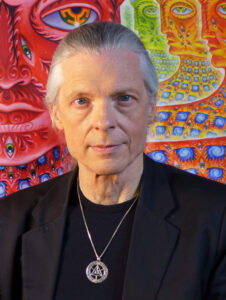
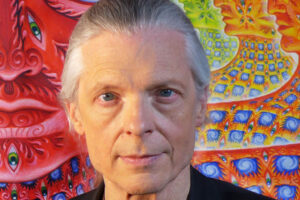
Alex Grey’s Artist’s Prayer in The Mission of Art
Creator of the universe,
How infinite and astonishing
Are your worlds.
Thank you
For your sacred art
And sustaining presence
Divine Imagination,
Forgive my blindness,
Open all my eyes.
Reveal the light of truth.
Let original beauty
Guide my every stroke.
Universal Creativity,
Flow through me,
From my heart
Through my mind to my hand,
Infuse my work with spirit
To feed hungry souls.
Art spans human history, from prelinguistic cavedweller to postmodern city dweller, and stands as witness to an ongoing creative process, an evolution of worldviews, a historic unfolding vision of nature, humanity, cosmos, and consciousness itself. Every work of art embodies the vision of its creator and reveals a facet of the collective mind. Artists offer the world the pain and beauty of their soul as a gift to open the eyes of and heal the collective. In order to produce their finest works, artists lose themselves in the energetic flow of creation, become possessed by an art spirit. Art history shows each successive wave of vision flowing through the world’s artists. Like the seers and oracles of old, Art sings and shouts from the axis of truth to wake us up to who we are and where we are going.
The genesis of art is a mystery buried deep in the psyches of our prehistoric ancestors. At least forty thousand years ago people started to draw, paint, and sculpt, and probably to make music. What is this deep need that drives humans to symbolize their feelings and ideas? Art can transfix and exert a strange influence over us; we freely and curiously give it our attention. Art seems to be a spark of the eternal coalesced with a distinct historic moment, driving artists to do something that witnesses their depth, that expresses their most personal and universal insights. Artists compose music, perform theater, paint pictures, sing songs, write poems and books, make cartoons, videos, websites. They somehow make their mark, and their art asks us to open our senses and take in the world anew, to experience and appreciate the full range of life in all its terror and glory, its strangeness and beauty. Art helps us maintain our creative excitement about life, and at its best, art can inspire and transform us. The mission of art advances as individual artists express their culture’s views of the world, in a personally hewn collective vision.
—Alex Grey, The Mission of Art, pages 1–9

